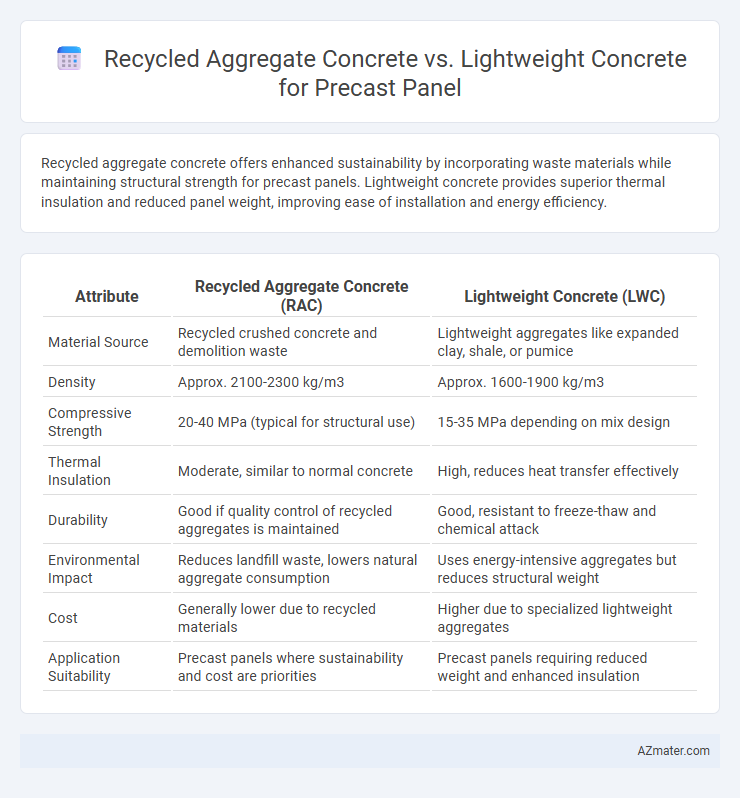Recycled aggregate concrete offers enhanced sustainability by incorporating waste materials while maintaining structural strength for precast panels. Lightweight concrete provides superior thermal insulation and reduced panel weight, improving ease of installation and energy efficiency.
Table of Comparison
| Attribute | Recycled Aggregate Concrete (RAC) | Lightweight Concrete (LWC) |
|---|---|---|
| Material Source | Recycled crushed concrete and demolition waste | Lightweight aggregates like expanded clay, shale, or pumice |
| Density | Approx. 2100-2300 kg/m3 | Approx. 1600-1900 kg/m3 |
| Compressive Strength | 20-40 MPa (typical for structural use) | 15-35 MPa depending on mix design |
| Thermal Insulation | Moderate, similar to normal concrete | High, reduces heat transfer effectively |
| Durability | Good if quality control of recycled aggregates is maintained | Good, resistant to freeze-thaw and chemical attack |
| Environmental Impact | Reduces landfill waste, lowers natural aggregate consumption | Uses energy-intensive aggregates but reduces structural weight |
| Cost | Generally lower due to recycled materials | Higher due to specialized lightweight aggregates |
| Application Suitability | Precast panels where sustainability and cost are priorities | Precast panels requiring reduced weight and enhanced insulation |
Introduction to Precast Concrete Panels
Precast concrete panels are widely used in construction for their efficiency and quality control, with materials influencing performance and sustainability. Recycled aggregate concrete enhances ecological benefits by incorporating crushed concrete waste, while lightweight concrete reduces structural load through materials like expanded clay or foam. Both options impact durability, thermal insulation, and load-bearing capacity, requiring careful selection based on project specifications and environmental goals.
Overview of Recycled Aggregate Concrete
Recycled Aggregate Concrete (RAC) utilizes crushed concrete and masonry waste as aggregates, offering environmental benefits by reducing landfill waste and conserving natural resources. Its mechanical properties depend on the quality and proportion of recycled materials, typically showing slightly lower compressive strength and higher water absorption compared to conventional aggregates. RAC provides a sustainable alternative for precast panels, balancing structural performance with eco-friendly construction demands.
Characteristics of Lightweight Concrete
Lightweight concrete used in precast panels primarily consists of lightweight aggregates such as expanded clay, shale, or pumice, resulting in a density typically between 1,200 and 1,800 kg/m3. It exhibits superior thermal insulation and reduced dead load compared to recycled aggregate concrete, enhancing structural efficiency and ease of handling. Its lower compressive strength, usually ranging from 15 to 40 MPa, requires careful design consideration to balance weight savings with mechanical performance.
Comparative Strength and Durability
Recycled aggregate concrete (RAC) exhibits higher compressive strength compared to lightweight concrete (LWC) due to the use of natural aggregates, enhancing structural load-bearing capacity in precast panels. LWC offers improved thermal insulation and reduced self-weight, which benefits transportation and installation but typically has lower tensile strength and durability against freeze-thaw cycles. Both materials show good durability in precast applications; however, RAC shows better resistance to abrasion and chemical attack, making it preferable for high-strength requirements, whereas LWC is advantageous for energy efficiency and reduced formwork loads.
Environmental Impact and Sustainability
Recycled aggregate concrete significantly reduces construction waste by repurposing demolished concrete, lowering landfill demand and conserving natural resources compared to lightweight concrete made from virgin lightweight aggregates. Lightweight concrete offers superior thermal insulation, leading to enhanced energy efficiency in buildings, but its production often involves higher embodied energy. Choosing recycled aggregate concrete for precast panels supports circular economy principles and reduces carbon footprint through material reuse, while lightweight concrete's sustainability benefits stem primarily from operational energy savings during building lifespan.
Workability and Casting Performance
Recycled aggregate concrete offers moderate workability due to the angularity and higher absorption of recycled aggregates, which can impact casting performance by requiring adjustments in mix design and compaction methods. Lightweight concrete exhibits superior workability with better flowability and reduced density, enhancing ease of casting and reducing formwork pressure in precast panel production. Both materials demand specific mix optimization to ensure efficient placement and structural integrity, with lightweight concrete generally providing smoother casting processes in precast applications.
Thermal and Acoustic Insulation Properties
Recycled aggregate concrete exhibits moderate thermal insulation with thermal conductivity values typically around 1.2-1.5 W/m*K, while lightweight concrete, especially those incorporating expanded polystyrene or aerated aggregates, offers superior insulation with thermal conductivity as low as 0.1-0.3 W/m*K. Acoustic insulation performance is enhanced in lightweight concrete due to its porous structure, providing better sound absorption coefficients compared to the denser recycled aggregate concrete. For precast panels aiming at energy efficiency and noise reduction, lightweight concrete presents a more effective solution in both thermal and acoustic insulation.
Cost Analysis: Initial and Life-cycle
Recycled aggregate concrete (RAC) offers significant initial cost savings due to lower material expenses and reduced waste disposal fees compared to lightweight concrete (LWC), which often involves higher costs from specialized aggregates and additives. Life-cycle cost analysis favors RAC by reducing environmental impact and enhancing sustainability, although LWC panels provide superior thermal insulation and durability, potentially lowering operational energy costs over time. When selecting precast panels, balancing upfront affordability with maintenance, energy efficiency, and environmental impacts is crucial for optimizing total cost of ownership.
Applications in Modern Construction
Recycled aggregate concrete offers enhanced sustainability and cost efficiency in precast panels, making it ideal for green building projects and urban development where environmental impact is a concern. Lightweight concrete precast panels excel in applications requiring reduced structural load and improved thermal insulation, such as high-rise buildings and modular construction. Both materials contribute to modern construction by addressing specific performance needs, with recycled aggregate concrete prioritizing resource conservation and lightweight concrete emphasizing durability and energy efficiency.
Conclusion: Selecting the Optimal Concrete Solution
Recycled aggregate concrete offers enhanced sustainability by incorporating waste materials, reducing environmental impact and promoting circular economy principles in precast panel production. Lightweight concrete provides superior thermal insulation and reduced structural load, improving energy efficiency and easing transportation logistics for large-scale construction. Selecting the optimal concrete solution depends on project-specific priorities such as environmental goals, structural requirements, and cost efficiency.

Infographic: Recycled aggregate concrete vs Lightweight concrete for Precast panel
 azmater.com
azmater.com